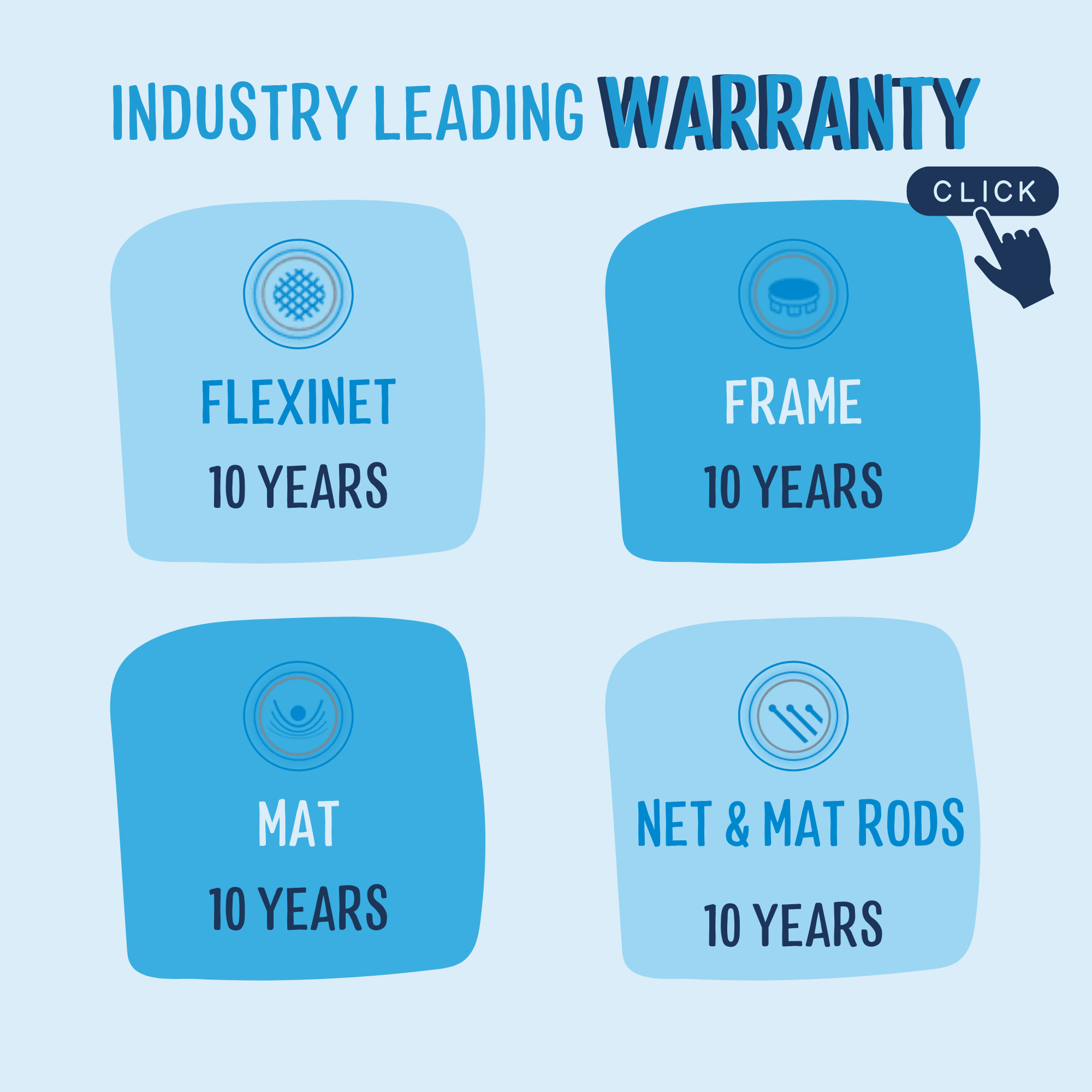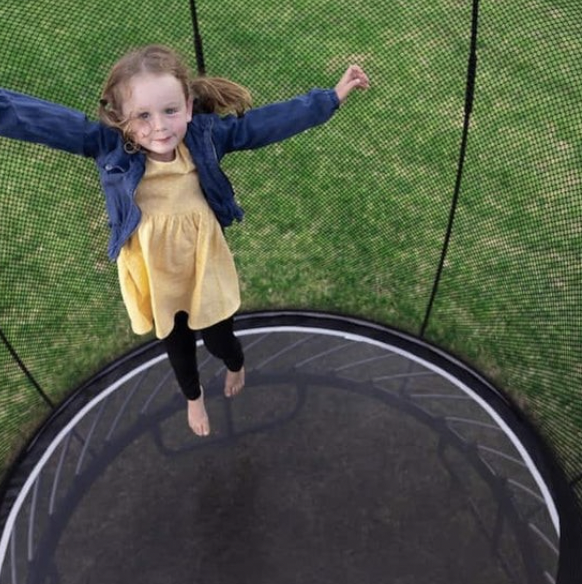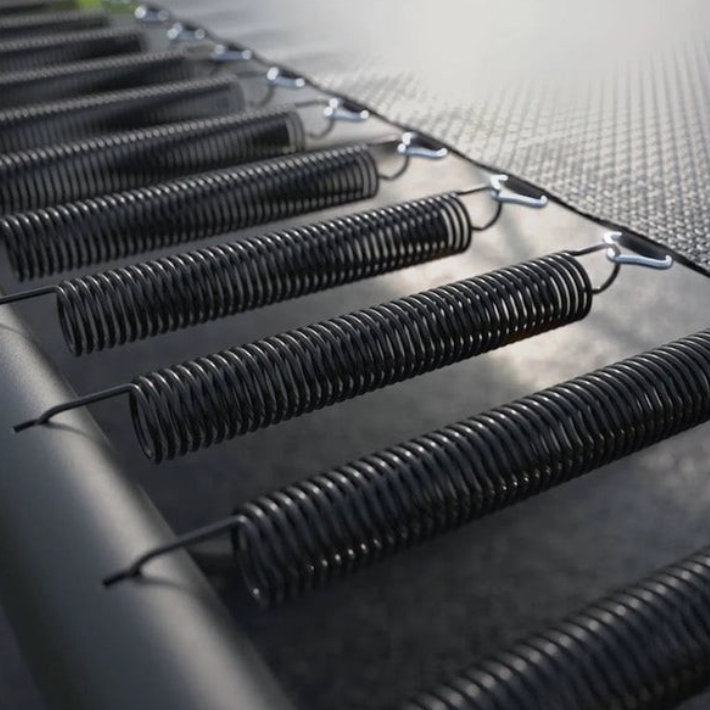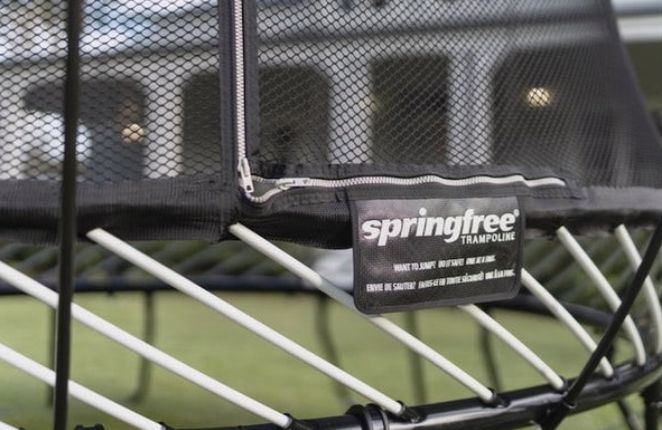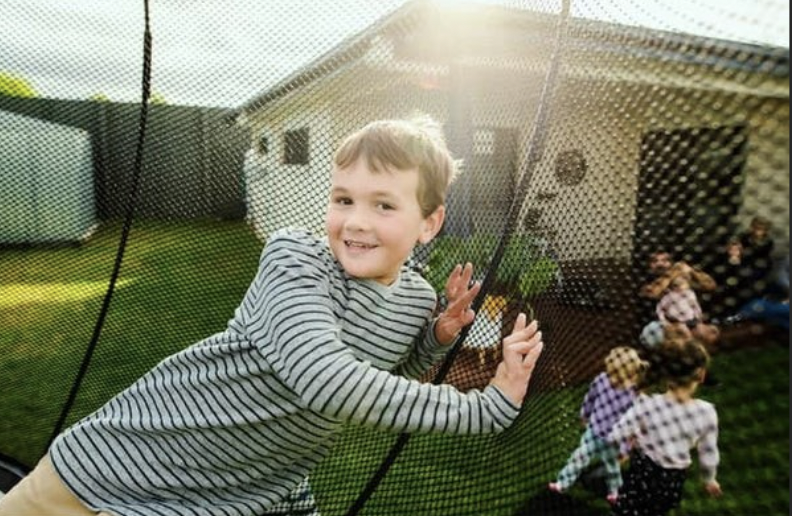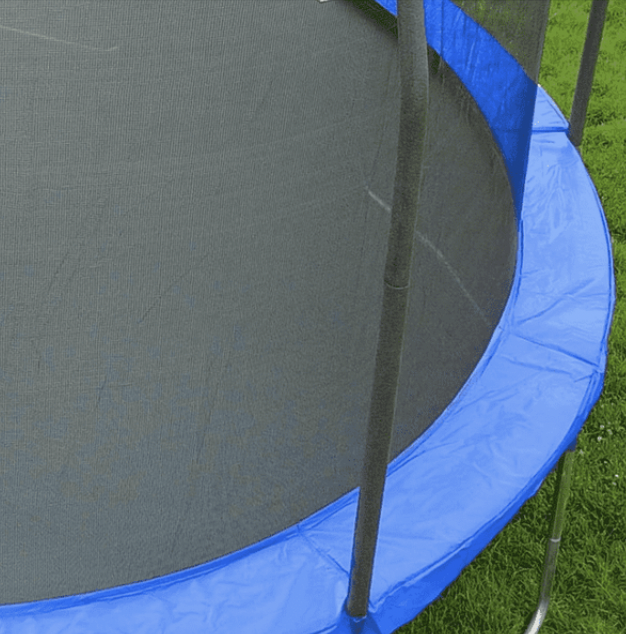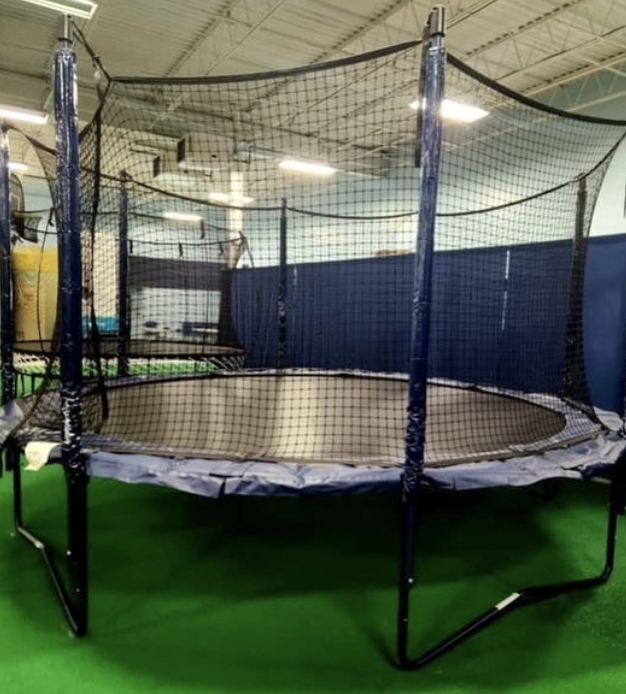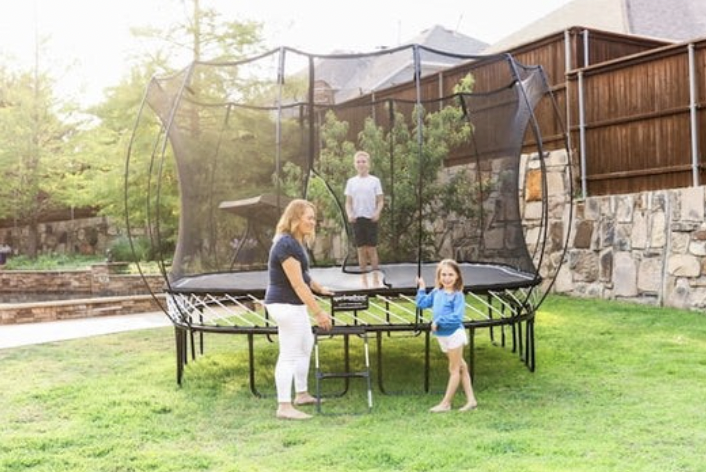Ever wondered, "What are trampolines made of?" Get the facts on trampoline components and their importance. Your guide to smarter, safer jumping starts here!
8 MIN READ
Have you ever looked at a trampoline and wondered, “What are trampolines made of?”
The answer is somewhat complicated. But we’re going to use our trampoline expertise to simplify it for you.
We will tackle each main trampoline component, providing insights into their construction.
More importantly, we’re going to tell you WHY it’s important to understand how a trampoline is made.
It can directly impact your trampolines’ safety, quality and longevity.
Translation: It’s pretty important.
What Materials Are Trampolines Made Of?
Most trampolines are made from the same materials, encompassing these five components:
Trampoline frame.
Trampoline mat.
Trampoline springs (or alternatives, as we will cover in our springless trampolines section).
Trampoline net (also called enclosure net).
Safety padding for the springs and metal poles.
Below you will find each of these components defined.
And don’t worry, this will be in plain English. We’re not going to get too technical!
1. What Are Trampolines Frames Made Of?
The frame of a trampoline is its structural backbone. Think of it like the human vertebrae.
Most trampoline frames are made from galvanised or powder-coated steel.
Photo courtesy of Trampoline Parts and Supply.
Galvanisation is crucial for the trampoline frame’s longevity. It involves the steel receiving a layer of zinc to prevent rust and corrosion.
Since the trampoline frame is the support structure for a trampoline, avoiding rust and age-related damage is essential. A rusty trampoline is dangerous to jump on.
Higher-quality trampolines will likely contain more galvanising and rust-resistant treatment.
For example, our Springfree Trampolines undergo a three-layer rust-proofing process. The frame also undergoes 3,000 hours of salt spray testing, which helps prevent damage from saltwater exposure.
Some smaller trampolines might use aluminium as a substitute for steel frames (think toddler trampolines).
But most, if not all, modern trampolines will have a galvanised steel frame.
The frame will come with legs made from the same material that helps keep the trampoline stable on the ground.
2. What Are Trampoline Mats Made Of?
Just like the frame, the trampoline mat material is consistent across the industry.
Trampoline mats are made of polypropylene material.
Springfree Trampoline mat.
Polypropylene is used because it:
Includes inherent resistance to UV light from the sun and water exposure.
Is resilient, and able to withstand the constant pulling and stretching that comes with bouncing.
Not all trampoline mats are created equal, though.
Even though most mats use polypropylene, some are made from higher-grade polypropylene.
The UV treatment undergone by the mat can also vary.
While polypropylene maintains embedded resistance to UV light, it will eventually wear down if exposed to direct sunlight frequently.
The density of the weave, UV-resistance and added treatment will help determine how long the mat will last.
3. What Are Trampoline Springs Made Of?
The trampoline springs are maybe the most synonymous feature of trampolines.
Most springs are made from galvanised steel (like the frame). This gives the springs the elasticity needed to stretch and recoil effectively.
Photo courtesy of ACON.
The springs may differ from the frame in how they are treated (UV or other), depending on the trampoline.
While traditional trampolines use metal springs, there is an alternative that we created in the early 2000s called the springless trampoline.
How do these differ from trampolines with springs?
What Are Springless Trampolines Made Of?
Springless trampolines replace the metal springs – a common place for injuries – with alternative materials.
Our Springfree Trampolines use flexible composite rods (made from fiberglass) to produce the bounce:
What are the advantages of using rods over springs?
They eliminate spring-related injuries – including those painful pinching injuries.
They are 3x stronger and 4x more flexible than steel.
They produce a bounce that’s softer and easier on your joints.
They provide more jumping room (springs take off roughly 2 ft of jumping room).
They maintain a quiet bounce, even as they age. Springs often get noisy as they age and rust.
There have been other springless alternatives besides our composite rods, such as elastic bands, as trampoline innovation has grown.
The downside to springless trampolines is they tend to be more expensive than most spring trampoline models due to their unique design.
4. What Is the Trampoline Net Made Of?
Believe it or not, there was a time when trampolines didn’t include nets.
When falling injuries were discovered to be caused largely by the lack of an enclosure net, things changed.
You won’t find many, if any, modern trampolines sold by manufacturers without nets.
Trampoline safety nets, or enclosures, are typically made from UV-resistant polyethylene or polyester materials.
These materials are chosen for their strength and ability to withstand significant force without tearing.
The idea is to make the netting fine enough to prevent fingers from getting caught but resilient enough to absorb the impact of a person falling against it.
But not all trampoline nets are created equal. Noticing a pattern?
Just like trampoline frames, mats and springs, there are differences in the quality of trampoline nets.
The net should contain strong UV treatment since it can wear down from sun exposure.
It should also be able to handle the jumpers’ weight on impact.
Cheap trampolines tend to have flimsy nets that don’t provide enough protection for the jumper. This is why falling injuries can still occur.
The trampoline enclosure net is EXTREMELY important.
It’s still common to see trampolines without nets in gardens today.
Our advice as trampoline safety experts is to never jump on a trampoline without a net. It’s not worth the risk!
5. What Is the Safety Padding Made Of?
The last major component of trampolines is the padding. You will typically see padding on:
The frame.
Over the springs.
On the metal poles.
On spring trampolines, the padding is usually made of thick, shock-absorbent foam.
This material is then covered with PVC or vinyl to help protect it from weather-related damage.
You will notice how sturdy the padding is just by looking at it.
Cheaper trampolines (£200-£400) typically have low-strength foam padding:
Photo courtesy of Google.
Higher-quality trampolines will have higher-strength padding:
Photo courtesy of Play N’ Learn.
Just like all outdoor trampoline components, the sun is the nemesis. That’s why proper UV treatment is a must for padding. Same with protection against saltwater exposure.
What Makes a High-Quality Trampoline?
The five components above make up the main structure of a trampoline.
While trampolines are made from the same elements (springless trampolines being the exception), they are not universally the same quality.
Here’s what to look for in a high-quality traditional trampoline:
Trampoline frame – Look for a frame made of strong galvanised steel that is UV-treated. Welded joints are typically better than relying on bolts and screws.
Trampoline mat - Opt for a mat made of UV-resistant, heavy-duty polypropylene fabric with reinforced stitching for strength. Look for a tight weave and attachment points to ensure secure installation.
Trampoline springs – Choose heavy-duty, rust-resistant galvanised steel springs with a sufficient length and thickness for optimal bounce and durability.
Trampoline net – Select a net made of high-quality, tightly woven polyethylene with reinforced edges and sturdy support poles. Ensure it meets ASTM safety standards for height, strength, and UV protection.
Trampoline padding - Seek thick, impact-absorbing foam padding with durable, waterproof outer covering. Make sure it provides full coverage over springs and frame, with secure attachment mechanisms to prevent slippage.
If you find a spring trampoline with these features, you can feel confident it is built to last. Your kids will thank you later!
As mentioned previously, springless trampolines are different than your typical trampoline.
For example, our Springfree Trampolines include the net, frame and mat, but the rods and lack of padding are different.
There’s no need for padding since it is a springless design with a frame that is “hidden” underneath the jumping surface.
Springfree Trampolines use premium-quality materials, and its safety-first construction is why they are largely considered the highest-quality Trampolines on the market.
FAQ: What Are Trampolines Made Of?
We’ve covered a lot so far. Let’s wrap this up by answering some frequently asked questions about what trampolines are made out of:
1. Are Trampolines Metal or Aluminium?
Trampolines are mostly made from galvanised steel, a variant of metal. You will see some smaller trampolines use aluminium for its lightweight properties.
2. Are Trampolines Made of Nylon?
Trampoline mats are typically made of polypropylene fabric, not nylon.
Polypropylene is known for its strength, flexibility, and resistance to stretching, making it ideal for withstanding the repetitive stresses of jumping.
3. Are Trampolines Made of Carbon Fiber?
Trampolines are generally not made of carbon fibre due to their high cost and specific applications in industries like aerospace and sports equipment.
4. Is a Trampoline Scrap Metal?
A trampoline can become scrap metal if it's no longer safe or functional, but it's not inherently considered scrap metal.
Old trampolines can be recycled for their metal components, such as the frame and springs, once they reach the end of their usable lifespan.
5. Do Trampolines Go Rusty?
Trampolines made of metal components can indeed rust, especially if they're exposed to moisture or harsh weather conditions over time.
High-quality trampolines with adequate galvanisation will be more protected from rust than lower-quality trampolines.
Regular maintenance, such as applying rust-resistant coatings or storing the trampoline indoors when not in use, can help prevent rusting.
6. Why Are Trampolines Bouncy?
Trampolines are bouncy due to the elasticity of their materials and design.
When a person jumps on a trampoline, the mat and springs (or rods/bands on springless trampolines) absorb the impact energy and then quickly release it, propelling the jumper upwards.
This rebound effect creates the bouncing sensation that makes trampolines fun and engaging for users!
What Is the Best-Quality Trampoline?
Talking about trampoline quality got us thinking: What is the best-quality trampoline you can buy?
We scoured through pages and pages of trampolines, going through all the major brands.
The result is an unbiased and thorough list of the best trampolines of 2024.
If you’re currently looking for a long-term trampoline for your garden, this List will be your greatest resource for the current top trampolines.
Happy jumping!







